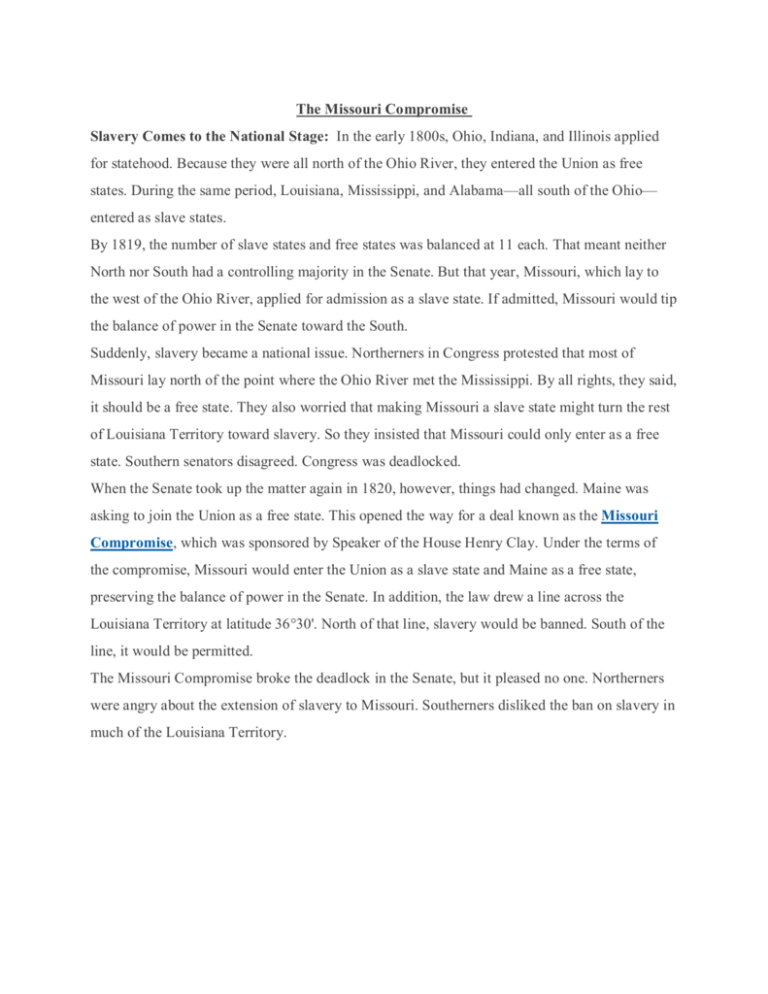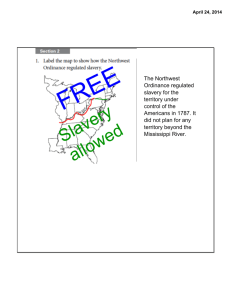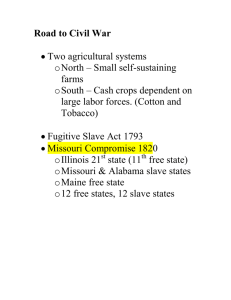The Missouri Compromise Slavery Comes to the National Stage: In
advertisement

The Missouri Compromise Slavery Comes to the National Stage: In the early 1800s, Ohio, Indiana, and Illinois applied for statehood. Because they were all north of the Ohio River, they entered the Union as free states. During the same period, Louisiana, Mississippi, and Alabama—all south of the Ohio— entered as slave states. By 1819, the number of slave states and free states was balanced at 11 each. That meant neither North nor South had a controlling majority in the Senate. But that year, Missouri, which lay to the west of the Ohio River, applied for admission as a slave state. If admitted, Missouri would tip the balance of power in the Senate toward the South. Suddenly, slavery became a national issue. Northerners in Congress protested that most of Missouri lay north of the point where the Ohio River met the Mississippi. By all rights, they said, it should be a free state. They also worried that making Missouri a slave state might turn the rest of Louisiana Territory toward slavery. So they insisted that Missouri could only enter as a free state. Southern senators disagreed. Congress was deadlocked. When the Senate took up the matter again in 1820, however, things had changed. Maine was asking to join the Union as a free state. This opened the way for a deal known as the Missouri Compromise, which was sponsored by Speaker of the House Henry Clay. Under the terms of the compromise, Missouri would enter the Union as a slave state and Maine as a free state, preserving the balance of power in the Senate. In addition, the law drew a line across the Louisiana Territory at latitude 36°30'. North of that line, slavery would be banned. South of the line, it would be permitted. The Missouri Compromise broke the deadlock in the Senate, but it pleased no one. Northerners were angry about the extension of slavery to Missouri. Southerners disliked the ban on slavery in much of the Louisiana Territory. The Compromise of 1850 A Compromise with Something for Everyone This problem came front and center when California applied for admission to the Union as a free state in 1849. California's entry as a free state would tip the balance of power toward the North. Of course, Northerners welcomed this idea, while Southerners strongly opposed it. Congress was deadlocked again, and some Southerners spoke of withdrawing from the Union. At this point, Henry Clay stepped forward with a plan known as the Compromise of 1850. Clay's plan had something for everyone. It admitted California into the Union as a free state, which pleased the North. It divided the rest of the Southwest into two territories—New Mexico and Utah—and opened both to slavery, which pleased the South. It ended the slave trade in Washington, D.C., but allowed existing slaveholders there to keep their slaves, making both sides happy. The Compromise of 1850 also included a strong Fugitive Slave Law. The new law required the return of escaped slaves to their owners, something slaveholders had been demanding for years. "All good citizens," it added, "are hereby commanded to aid and assist in the prompt and efficient execution of this law." Those who did not could be fined or jailed. To get his plan through Congress, Clay persuaded Senator Daniel Webster of Massachusetts to lend his support. Webster opposed slavery, but he agreed to support Clay's compromise in an effort to end the crisis. The Compromise Satisfies No One Clay and Webster hoped the Compromise of 1850 would placate both sides and help ease tensions over slavery. Instead, the compromise pleased almost no one. The Fugitive Slave Law caused particular friction. The law allowed Southern "slave catchers" to come north to retrieve escaped slaves and required Northerners to come to the aid of these slave catchers or face fines, even imprisonment. Many Northerners felt the law was immoral and refused to obey it. Their resistance outraged Southerners. The Publication of Uncle Tom’s Cabin The Publication of Uncle Tom’s Cabin Friction between the sections was further intensified by publication in 1852 of Uncle Tom’s Cabin. In this best-selling novel, Harriet Beecher Stowe described the cruelties of slavery through the story of a dignified slave named Uncle Tom. The novel describes Tom’s experiences with three slaveholders. Two of them treat Tom kindly. The third, Simon Legree, abuses Tom and has Tom beaten to death for refusing to tell where two escaped slaves are hiding. Stowe hoped her novel would help bring slavery to a quick and peaceful end. Instead, the book increased the hostility of many Northerners toward the South. Southerners, in turn, saw Stowe’s description of slavery as both inaccurate and an insult to their way of life. The Kansas-Nebraska Act and Bleeding Kansas Let the People Decide: The Kansas-Nebraska Act In 1854, another act of Congress set the North and the South on a collision course. That year, Senator Stephen Douglas of Illinois introduced a bill to organize the Great Plains for settlement. Because this area lay north of the Missouri Compromise line, the bill did not mention slavery. Southerners in Congress agreed to vote for the bill if the two new territories—Kansas and Nebraska—were organized on the basis of popular sovereignty, which means the territories would vote to decide. With Southern support, the Kansas-Nebraska Act made it through Congress. The Kansas-Nebraska Act dismayed many Northerners. Now they feared slavery would spread like a plague across the country. To prevent that from happening, antislavery activists and settlers, or Free-Soilers, united to form a new political party in 1854. The new Republican Party took a firm stand against the Fugitive Slave Law and the Kansas-Nebraska Act. By 1855, settlers were pouring into Kansas. Most were peaceful farmers seeking good land to farm. But the territory also attracted agitators, or protesters, who wanted to influence the vote on slavery. Abolition societies in the North sent in Free-Soilers, while groups in the South recruited proslavery settlers to occupy Kansas. From Missouri, armed agitators called “border ruffians” crossed into Kansas and threatened the Free-Soilers. On May 21, 1856, proslavery forces raided the Free-Soil town of Lawrence, Kansas. They burned buildings, looted stores, and destroyed two printing presses. Antislavery activists led by John Brown met violence with violence. Brown was an antislavery zealot who had dedicated his life to ending slavery by any means necessary. Two days after the Lawrence raid, Brown and seven of his supporters attacked the proslavery town of Pottawatomie. They dragged five men out of their homes and killed them with their swords. Brown’s massacre prompted still more bloodshed in Kansas, as proslavery and antislavery forces battled for control of the territory. But the violence was not restricted to Kansas. It was also infecting the nation’s capital. The day after the Lawrence raid, Preston Brooks attacked and beat Charles Sumner on the Senate floor. Despite efforts at compromise, the struggle over slavery was getting more violent. The Dred Scott Decision Like many slaves, Dred Scott and his wife, Harriet, wanted their freedom. But rather than run away, they tried to win it legally. In 1846, they sued for their freedom in a St. Louis, Missouri, court. The Scotts had lived with their owner for several years in the free territory of Wisconsin. They based their court caset on the argument that living in a free territory had made them free people. The Dred Scott Decision Outrages the North In 1856, the case of Scott v. Sandford reached the Supreme Court. The Court, led by Chief Justice Roger Taney, faced two key questions. First, did slaves have the right to bring a case before a federal court? Second, did the Scott’s stay in Wisconsin make them free? Taney, however, saw in this case the opportunity to resolve the slavery issue once and for all. He asked the Court to consider two additional questions. Did Congress have the power to make laws concerning slavery in the territories? If so, was the Missouri Compromise a constitutional use of that power? The Court issued the Dred Scott decision in 1857. It began by reviewing the Declaration of Independence’s words that “all men are created equal.” Writing for majority, Taney said, The Court also rejected the idea that Scott’s stay in Wisconsin had made him a free man. Taney reasoned that giving Scott his freedom would be like taking property from his owner. The Fifth Amendment to the Constitution protects private property. Thus, the Missouri Compromise was unconstitutional by establishing territories “which prohibited a citizen from holding or owning property of this kind.” The ruling struck the nation like a bombshell. Southerners were thrilled. They believed the Court had settled the slavery question in their favor. Northerners were stunned. The Court’s decision had invalidated the whole idea of “free soil” and opened all territories to slavery. “The decision,” wrote a New York newspaper, “is the moral assassination of a race and cannot be obeyed.” John Brown’s Raid on Harpers Ferry John Brown’s Raid on Harpers Ferry Shocks the South The Dred Scott decision helped convince radical abolitionists like John Brown that slavery would never be ended by legal means. In 1859, Brown decided to try a different approach—he provoked an armed uprising of slaves to free themselves. With 21 other men, Brown seized the federal arsenal at Harpers Ferry, Virginia. An arsenal is a place where guns and ammunition are stored. Brown intended to distribute the weapons to slaves in the area and spark a slave revolt. Brown’s plan was thwarted when federal troops stormed the arsenal and captured him and his men. Brown was tried for treason, convicted, and executed. Even so,John Brown’s raid on Harper’s Ferry shocked the South and prompted widespread fears of a slave rebellion. Most Southerners saw Brown as a lunatic whose extreme views were representative of the antislavery movement. Many Northerners, on the other hand, saw Brown as a hero and martyr to the cause of abolition. Poet and philosopher Ralph Waldo Emerson declared that Brown would make the gallows “as glorious as a cross.” When the Civil War began a few months later, Union troops marched into battle singing, “John Brown’s body lies a-mouldering in the grave, His soul goes marching on.” The Election of Lincoln in 1860 The Election of 1860 Splits the Nation The presidential election of 1860 drove a final wedge between North and South. Sectional strains had split the Democratic Party into northern and southern factions, or competing groups. Northern Democrats nominated Stephen Douglas of Illinois and backed popular sovereignty in the territories. Southern Democrats picked John C. Breckinridge of Kentucky, who wanted slavery to be allowed in all territories. John Bell of Tennessee, who ran as the candidate of the Constitutional Union Party, tried to avoid the divisive issue of slavery. Abraham Lincoln was the Republican Party nominee. Lincoln, an Illinois lawyer, was a moderate but firm opponent of slavery. In a famous series of debates against his opponent, Stephen Douglas, Lincoln had condemned slavery as "a moral, social, and political wrong." Lincoln won the presidency with less than 40 percent of the votes, all of them cast in the North. His name did not even appear on the ballot in many Southern states. Lincoln's victory raised the cry of secession, or withdrawal from the Union, in the South. Southerners feared that with a Republican in the White House, Congress would try to abolish slavery. Lincoln tried to calm Southern fears. He said he would not interfere with slavery in the South. He also said he would support enforcement of the Fugitive Slave Law. But he refused to support the extension of slavery to the western territories. On that question, he said, there could be no compromise. Secession Spreads Across the South Lincoln tried to hold the nation together, but his efforts had little effect. On December 20, 1860, South Carolina seceded from the Union. Over the next several weeks, six more Southern states pulled out. Together they formed the Confederate States of America, with Jefferson Davis as president. On April 12, 1861, Southern forces opened fire on Fort Sumter, a federal fort in Charleston harbor. After a day and a half of bombardment, the troops in the fort surrendered. The Civil War had begun.







